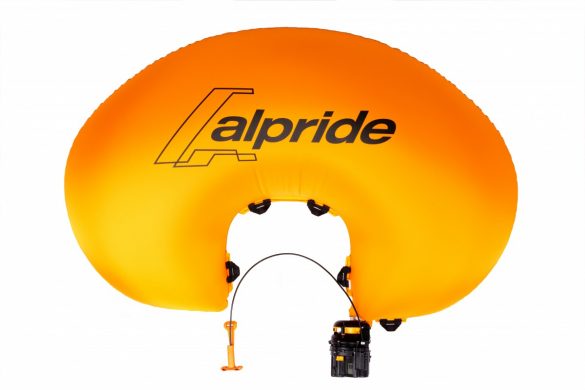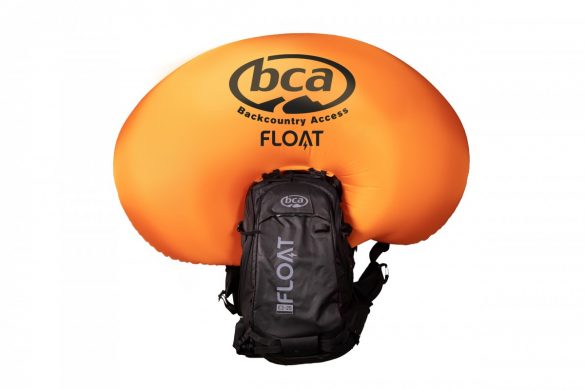Swiss-based Alpride will begin selling its new electronic (supercapacitor) airbag system this fall. WildSnow has a test/review airbag from BCA, their new Float E2 25, which integrates with the E2 system. Speaking of ease of use and seamlessness, BCA has crafted a stout pack in the FLOAT E2 25 to complement the E2’s Swiss engineering. In part one, I dove into the pack’s merits and minor flaws. Part two, as the title suggests, examines the airbag system and how well it gels with the pack.
WildSnow covered Alpride’s E1 system in the past, beginning in January of 2018. Three years-ish later, Alpride introduces the E2. As with most 2.0 versions, we see a reduction in overall weight and size.
According to Alpride, here are the comparative specs:
– E2 compressor is 40% smaller: 1.19 liters of useful volume vs 2.05 liters for E1.
– E2 kit airbag is 140g. lighter: 1140g. vs 1280g for E1.
– E2 airbag balloon is 12 liters larger: 162 liters vs 150 liters for E1.
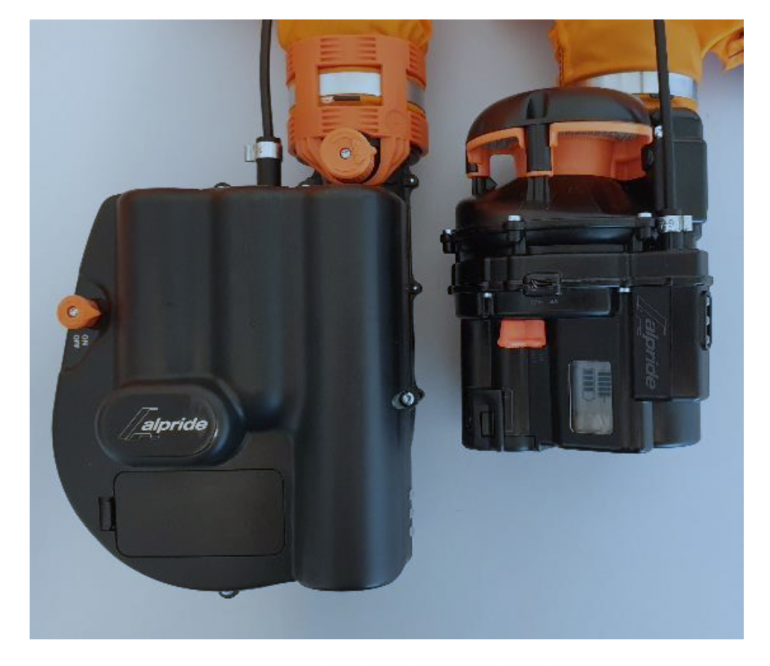
A side by side shot of the E1 system (left) and the smaller/lighter E2 system (right). Photo: Alpride.
The upgrades also include an LCD screen indicating supercapacitor and AA battery charge levels. There’s also an externally accessible deflation button (ease of use is key) and a move to USB-C for faster charging. (Let’s assume by the time E3 is released, an even better USB port will be standardized, making our cord drawers even more Medusa-like.)
An automatic pressure relief valve is triggered three minutes after the airbag inflates. This feature ensures compliance with EN16716, which specifies European standards for avalanche airbag systems.
Deflation
There’s a lot to cover. Let’s begin with EN16716 and auto-deflation. Like precise Swiss timing, three minutes after inflation, you’ll hear what sounds like a slow leak. That’s the pressure relief valve doing its work. And according to the EN16716 standards, the Alpride’s manual states the release valve opens after three minutes but only for a maximum duration of, “10 minutes or less depending on the residual energy in the batteries or SuperCapacitors. It will then close automatically.”
The auto-deflation feature is not, in fact, purpose-built for your immediate safety in the event of burial. Many users like the psychic comfort of an inflated airbag reverting to auto-deflate after three minutes to hopefully form an air pocket. The rate of deflation I’ve experienced with the E2, safely in my home, is slow. I’m guessing that even with the immense pressure of snow over your head, the rate of deflation would be too slow to help form an air pocket. The auto-deflation is programmed into the software to prolong the lifespan of the airbag by reducing stress on the bag’s seams and fabric.
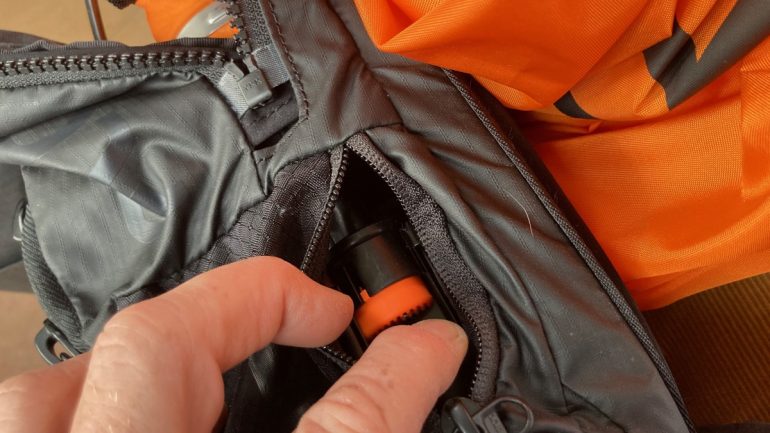
Unzip the small side “window,” slide a cover, and press the orange release valve to expedite deflation.
The Float E2 25 has an easy zipper access nylon/mesh-enclosed “window” to reach the orange-colored deflation button. The button is protected from accidental engagement by a spring-loaded cap. It’s easy enough to slide open and press, but it takes a bit of feeling around and practice. Folding the airbag up after deployment and deflating requires some ballet to both lay on the airbag to deflate it and keep the deflation button engaged. With practice, this is not a big deal, and better that engineers design a deflation button that appears impossible to trigger accidentally.
Charging – Triggering – Discharging
The E2 comes on the heels of Alpride’s E1 system, the brand’s first supercapacitor system. I’ll not dive into the physics, but the E2 system does not rely on charging a lithium-ion battery to power the system, the supercapacitors store the energy. (The supercapacitors are topped off after the first inflation by the AA batteries. More on this process below.) The E2 system is rated as reliable in temps ranging from -30 Celsius to +50 Celsius, which makes the system suitable for most places you’d want to ski on the planet.
So, easy peasy, you plug and charge the supercapacitors with a USB-C cord (included). Alpride claims this process takes 20-40 minutes. I can confirm that the recharge is that fast, but safe to have at least 30 minutes.
You have two methods to check the system’s charge status. The E2 has a small LCD screen with an icon denoting the charge status. The screen is accessible on the Float E2 25 (and other packs integrating the E2 system) by unzipping a small protective pouch in the pack’s main compartment. In a well-lit room or outside, it’s relatively easy to read the LCD screen, it’s not backlit. I’ve used my phone’s light to get a better look on a few occasions. The unit must be powered on to get a readout on the screen.
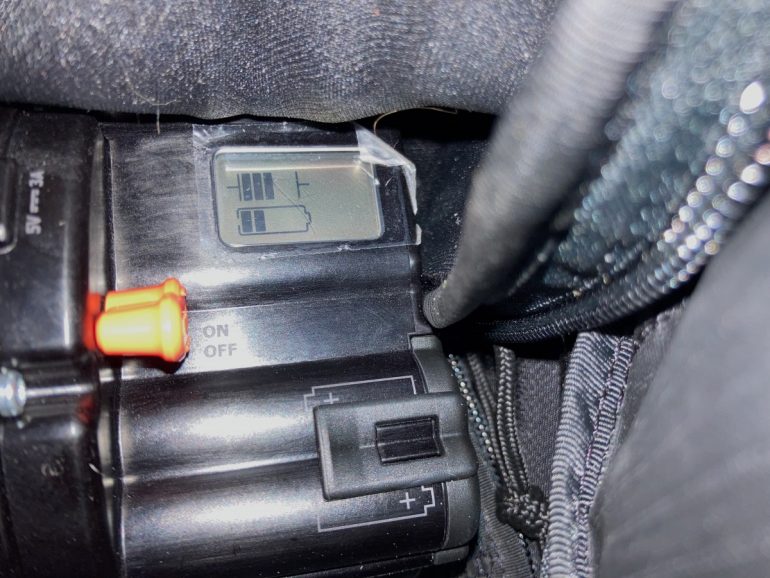
One way to check the charge status is to read the LCD screen when the unit is powered up.
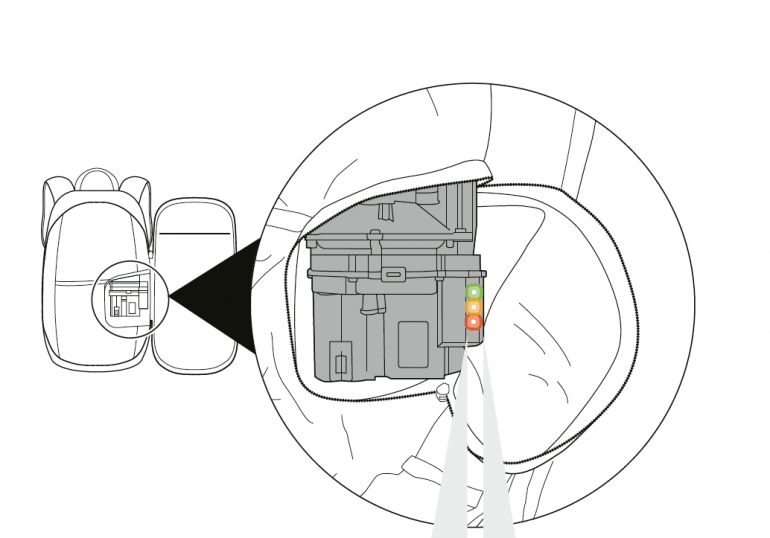
Another method to check charge status and system readiness is to look at the flashing lights on the side of the housing for the supercapcitors.
The screen readout is a nice improvement for those who like to double-check and want redundancy. Along with the LCD screen, you can also see flashing lights through the nylon/mesh fabric (mentioned in the deflation section above). The light scheme is simple and similar to those familiar with Alpride’s E1 system. Note the summary of the LED statuses below. But green is good, yellow means to take some caution, and red flashing indicates its time to charge the system up: “Red: low charge – the charge level cannot guarantee full inflation of the airbag (but it will still attempt to inflate the airbag as much as possible).”
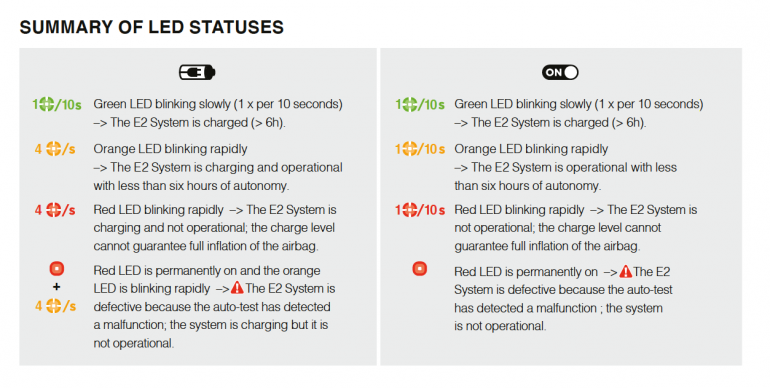
I pulled the trigger with the red flashing light and got partial inflation. Let’s assume “as much as possible” will not save your life. Be conservative and aim for a full charge.
The E2, also like the E1, allows for two AA batteries to help maintain the charge, which Lou called “topped off” in his E1 evaluation. The AAs also serve to recharge the supercapacitors when external power is unavailable, and the supercapacitors need an energy reboot after one trigger pull/airbag inflation. Alpride claims it takes approximately 40 – 80 minutes to recharge fully with fresh AAs. This time frame is accurate and confirmed. The system requires Alkaline or Lithium AAs; I’ve had Alkaline on hand for the testing.
And, here, in fact, let’s dig into the idea of autonomy and the E2 system, which the AAs help ensure. (You can determine the AAs charge on the LCD screen.)
Most often, “autonomy” is a beautiful thing. In this case, it’s a win too. “Autonomy” describes the E2’s ability to remain charged and functional without replenishing energy with an external USB-C assist. With new AAs (good quality) and the system powered off, the E2 should remain safe to use for two to three months, according to Alpride. I’ve not tested it past a month, but the system remained charged, with a successful deployment, after sitting autonomously for almost 30 days.
The E2 system can be used, once fully recharged, without AAs installed. Absent AAs, Alpride claims 12-24 hours of autonomy is the usual duration of system viability (meaning the airbag will 100% fill for a single trigger pull). Be warned; if you pull the trigger but have no AAs installed, the system’s duration of autonomy is reduced. Meaning, that I get a single successful trigger pull/airbag fill (read 100% filled) per charge and no AAs to support a recharge. I tested this after the E2 system was turned off for 15 hours. (After the one successful pull, the red LED blinked – and later, with no recharge, a second trigger was unsuccessful.)
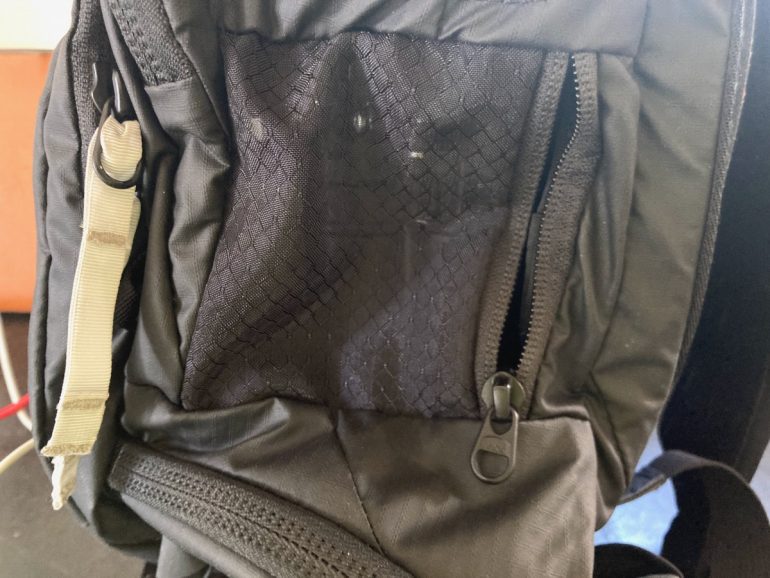
The nylon/mesh panel can be unzipped to access the deflate valve. Zipped up, it’s easy to see the LED lights flashing to indicate charge and system readiness.
And to circle back, the blinking lights indicate the duration of autonomy. But, if you use the E2 system, be safe, slot some fresh AAs in, and regularly check their charges. And, best be prepared if you are out for more than a day and carry some spare AAs. This system is most reliable with AAs installed.
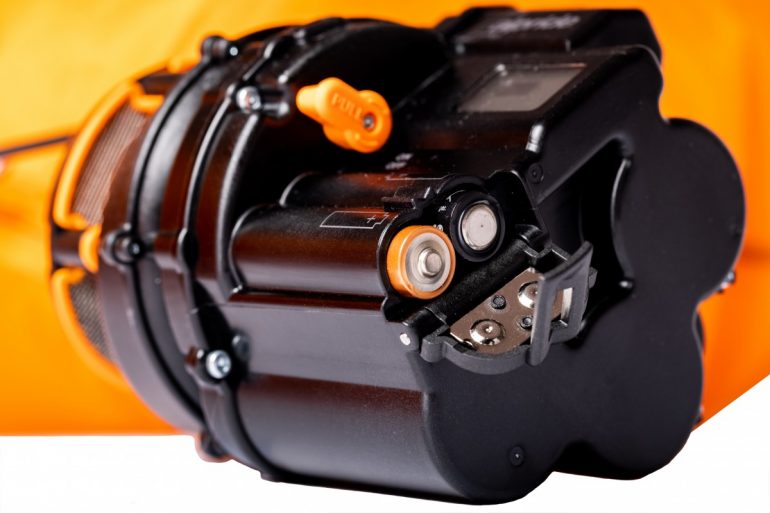
A studio shot of the AA battery placement. Photo: Alpride.
We left off with the AAs, so I’ll jump back into the AAs and their ability to recharge and top off the system once the system is triggered.
I charged the E2 system fully using the USB-C and added two fresh Alkaline AAs. I pulled the trigger – all systems go-the turbo spun, the bag inflated. I folded the airbag, zipped up all the relevant compartments, waited 30 minutes, and pulled the trigger again. Repeat: all systems go – the turbo spun – the bag inflated. I repeated this scenario a third time with the airbag inflating to maybe half capacity. Alpride states, “2 AA batteries allow for 1-2 recharging cycles of the SuperCapacitors.” Using fresh Duracell alkaline AAs, I had one successful recharge cycle. I suspect using Lithium AAs, you’ll get more recharge cycles. That piece is to be continued.
Inflation
Turn the system on, which is easy with the turn of a small orange toggle. The system awakens with an auto-test to ensure proper function. You’ll hear the motor make a slow reassuring rotation. The LCD screen will illuminate and display charge levels, first the green, then the yellow LED blinks. You’ll hear a second turn of the motor which concludes the sweet sound and visual sequence indicating the system functions.
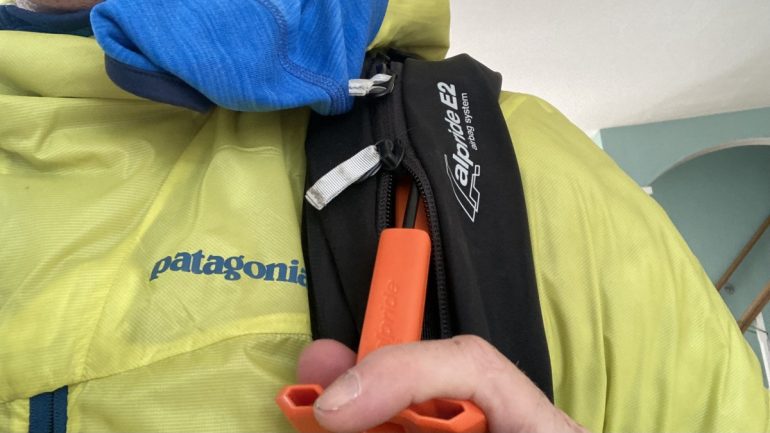
The trigger system is clean, simple, and does the job.
You’ve got the option on the BCA Float E2 25 to route the trigger to the right or left shoulder strap. Set the proper trigger height, and pull the trigger. The turbo/fan runs for five seconds, while it takes the bag 3-4 seconds (my times were in the three-second range) to inflate fully. Then the auto-deflation begins after three minutes.
For many, the upsides of the electronic system manifest in their ease of charging, trigger pulling, inflation, and repacking, which means more straightforward in-the-field practice and testing without fiddling with canisters and seals and manual pumping or finding a repressurizing service. Canister systems and their relatives used for safety in the transportation sector have been around for years. Canister systems, however, are fickle when considering air travel. Until further notice, assume the E2, and other electronic systems are easy to fly with.
Whether it’s industry intent or not, there’s something 100% comforting about testing an airbag and having it inflate. I’ve mentioned this before, but it’s reminiscent of placing a helmet on my head; it’s reassuring. I’m not foolish enough to think there’s any serenity or comfort, for that matter, in a real deal %&$!-storm of an avalanche. But knowing I’ve got a reliable system to make me more buoyant in the unrelenting world of fast-flowing snow is insurance; in this test, the E2 system is up to the task.
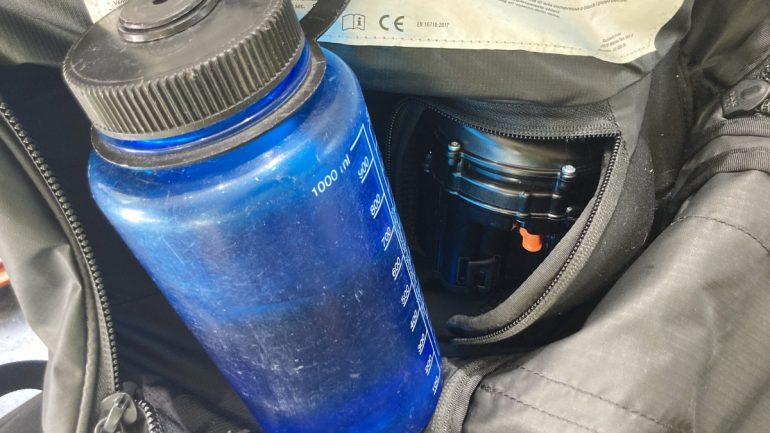
The bulk of the E2 systems (sans airbag) nested into the BCA FLOAT E2 25.

The bulk of the E2 system (sans airbag) and zipped up, nested into the BCA FLOAT E2 25.
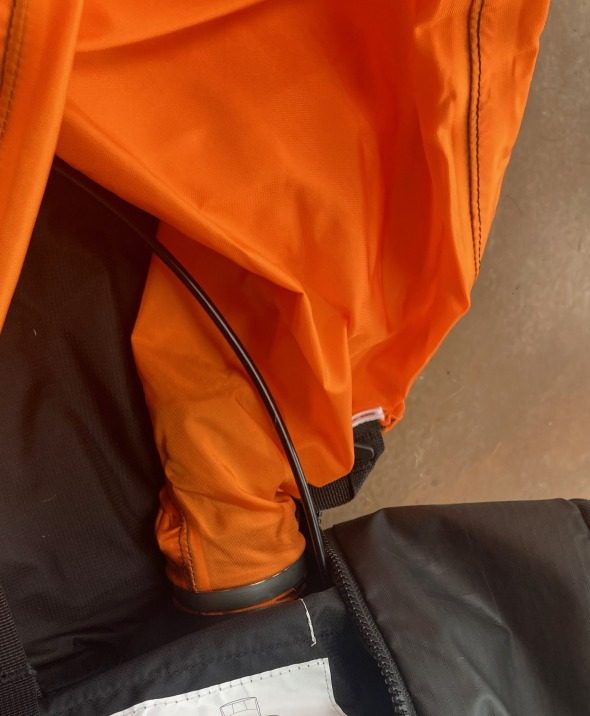
Shown here is the interface of the airbag and the housing for the turbo fan and supercapacitors.
Back to the Pack
Familiarization is critical here. Get to know the pack and the E2 system. I’ve learned that a non-airbag pack and airbag pack are part of similar ecosystems, but they are markedly different tools. (Think of the loads and forces an airbag pack is subjected to in the worst-case scenario.) Airbag packs and the Float E2 25 they just have more of everything: More zippers, more hardware, webbing, tabs, and compartments. More weight. More complexity. The irony is that these are sophisticated tools designed to be simple in emergencies. I’d say BCA and Alpride have done a fine dance considering the comingling of their assets. This is not plug-and-play, although using the BCA FLOAT E2 25 trends towards feeling that way.
In terms of using the pack with the E2 system installed, BCA did not fail and, considering your tastes in styles, excelled. Yeah, the spaces are tight in this 25L pack, so checking the LCD screen with gear stuffed in required some unpacking.
This brings up something I’ve been thinking about relating to packs and clothing, and gear. There remains a decidedly fast-Lycra-sleek look we often coin as “Euro”. The same can be said of relaxed, flow, and baggy as terms associated with the cultivated “flow-state” vibe of the American backcountry. BCA earns good style and design points, meaning “relaxed” and unassuming, in the Float E2 25, despite it being a state-of-the-art product you’re hauling into the woods and mountains and maybe counting on to save your life.
There are other ways of presenting to the world beyond “chill,” as each company has its DNA, taglines, and imprint. Mammut, for example, has their orange. Dynafit has that slim fit and skimo shuffle. BCA pushed the beacon industry towards digital years ago. They are, in their own way, that rare combo of high-tech and cutting-edge and relaxed. The branding on this pack is understated and the colors absent a look-at-me palette. The BCA Float E2 25 lets you embrace that philosophy and heritage with an understated low-ego and big featured airbag pack.
Summer Storage for E2 System
What are the storage requirements for the capacitor systems?
From Alpride: remove the AA batteries for summer / long storage, nothing to do for Super Capacitors
Can the Super Capacitors be left uncharged for the off-season without degrading?
From Alpride: It’s a great advantage of the Supercapacitors, as it’s a passive electronic element (without chemical reaction as Li-Ion batteries), you can store it for during months/years without degrading. The quality and the performance of Supercapacitors are stable in time, even after long storage or intensive use (we did 10’000 inflations with the same E2 during the test/development phase).
Using a combination of removable AA batteries and Supercapacitors, without any Li-ion battery degrades after long storage, time, or intensive use) guarantees years after years the same performance and quality.
Jason Albert comes to WildSnow from Bend, Oregon. After growing up on the East Coast, he migrated from Montana to Colorado and settled in Oregon. Simple pleasures are quiet and long days touring. His gray hair might stem from his first Grand Traverse in 2000 when rented leather boots and 210cm skis were not the speed weapons he had hoped for. Jason survived the transition from free-heel kool-aid drinker to faster and lighter (think AT), and safer, are better.

